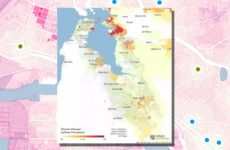
World Hubs in 2025
The globe is expanding rapidly, and as it does, more mega cities (populations of 8 million+) are beginning to develop. People are drawn to city cores because, unless their business is online, the majority of jobs are found in these populated hubs. The World Resource Institute thinks that by 2025, the world will have around 33 mega cities.
Particularly in Asia, the need for bigger city centers has spurred plans for mass expansion.
"The number of urban dwellers is expected to hit 5 billion globally by 2025--double the number of 1990" according to Forbes Magazine's article which listed the 10 Biggest Cities of 2025.
Even if telecommuting becomes bigger in the future, there is no doubt people will continue to inhabit city cores. People have a natural affinity for social interaction, a need built into our nature. Real life social interaction won't be replaced by social networking and teleconferencing, it will only make the desire to connect face to face stronger.
"Asia and Latin America, each cluttered with rural workers looking for better jobs and housing in the city, are slated to have nine of the world's 10 most populous cities by 2025," Forbes explains, listing specifics like Mumbai, Calcutta, Delhi, Karachi, Shanghai, Mexico City and Sao Paulo.
"New York and Tokyo are the only traditional power cities expected to remain on the mega cities list in 17 years," Forbes adds.
Tokyo, which is now at a population of 35.2 million is project to hit 36.4 million by 2025. Mumbai will jump from 18.2 million today to 26.4 million; Delhi from 15 million to 22.5 million; Dhaka from 11.9 million to 22 million; Sao Paolo from 18.3 million to 2.4 million; Mexico City from 19.2 million to 21 million; New York from 18.7 million to 20.6 million; Calcutta from 14.7 million to 20.6 million; Shanghai from 14.5 million to 19.4 million; Karachi from 11.6 million to 19.1 million
The images in the gallery are from the Forbes article.
Particularly in Asia, the need for bigger city centers has spurred plans for mass expansion.
"The number of urban dwellers is expected to hit 5 billion globally by 2025--double the number of 1990" according to Forbes Magazine's article which listed the 10 Biggest Cities of 2025.
Even if telecommuting becomes bigger in the future, there is no doubt people will continue to inhabit city cores. People have a natural affinity for social interaction, a need built into our nature. Real life social interaction won't be replaced by social networking and teleconferencing, it will only make the desire to connect face to face stronger.
"Asia and Latin America, each cluttered with rural workers looking for better jobs and housing in the city, are slated to have nine of the world's 10 most populous cities by 2025," Forbes explains, listing specifics like Mumbai, Calcutta, Delhi, Karachi, Shanghai, Mexico City and Sao Paulo.
"New York and Tokyo are the only traditional power cities expected to remain on the mega cities list in 17 years," Forbes adds.
Tokyo, which is now at a population of 35.2 million is project to hit 36.4 million by 2025. Mumbai will jump from 18.2 million today to 26.4 million; Delhi from 15 million to 22.5 million; Dhaka from 11.9 million to 22 million; Sao Paolo from 18.3 million to 2.4 million; Mexico City from 19.2 million to 21 million; New York from 18.7 million to 20.6 million; Calcutta from 14.7 million to 20.6 million; Shanghai from 14.5 million to 19.4 million; Karachi from 11.6 million to 19.1 million
The images in the gallery are from the Forbes article.
Trend Themes
1. Rapid Urbanization - The expansion of mega cities indicates a trend of rapid urbanization globally, creating opportunities for infrastructure development and urban services innovation.
2. Increased Job Opportunities - The growth of mega cities leads to an increase in job opportunities in various industries, presenting a chance for businesses to tap into emerging markets and cater to urban workforce demands.
3. Urban Socialization - As mega cities thrive, the need for social interaction and community building becomes crucial, creating opportunities for businesses to provide innovative solutions that foster connection and engagement among urban dwellers.
Industry Implications
1. Urban Infrastructure - The expansion of mega cities calls for disruptive innovation in urban infrastructure, including transportation, housing, and utilities, to accommodate the growing population and enhance quality of life.
2. Technology and Telecommunications - As telecommuting becomes more prevalent, businesses in the technology and communications sectors have an opportunity to develop innovative solutions that support remote work, connectivity, and efficient communication within mega cities.
3. Hospitality and Entertainment - With the need for social interaction and community building in mega cities, there is potential for disruptive innovation in the hospitality and entertainment industries, such as creating unique experiences, co-working spaces, and communal gathering places.
2.1
Score
Popularity
Activity
Freshness























